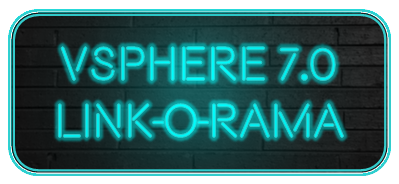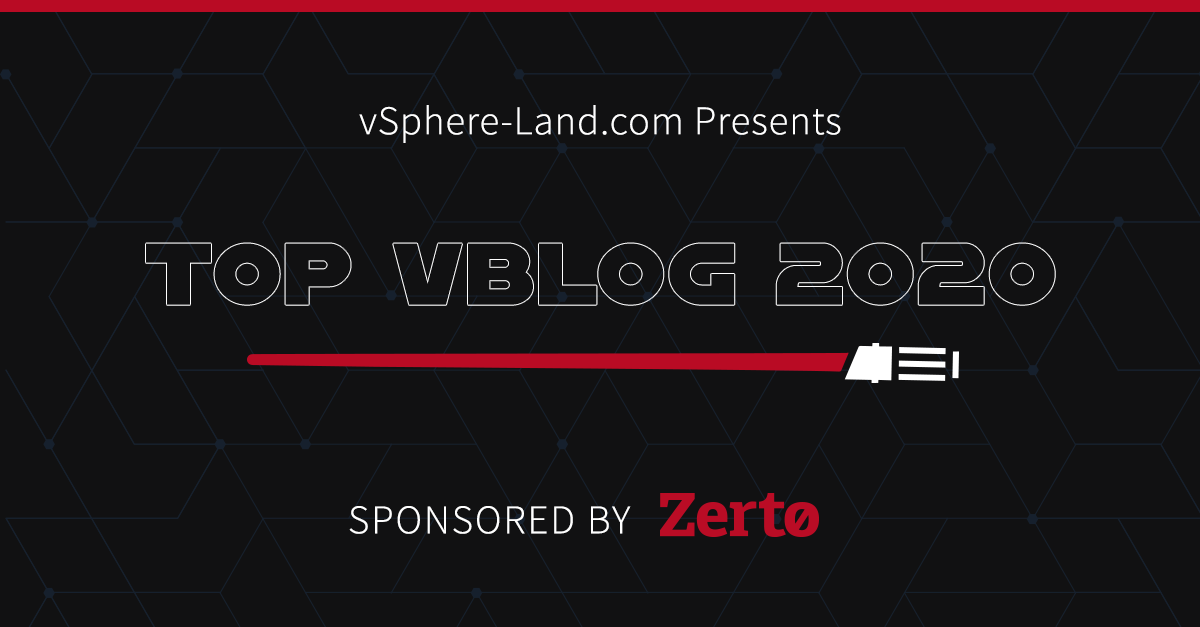 Your complete guide to all the essential vSphere 7.0 links from all over the VMware universe.
Your complete guide to all the essential vSphere 7.0 links from all over the VMware universe.
Bookmark this page and keep checking back as it will continue to grow as new links are added everyday.
Also be sure and check out the Planet vSphere-land feed for all the latest blog posts from the Top 100 vBloggers.
VMware announces vSphere 7.0: Here’s what you need to know (vSphere-land)
Introducing vSphere 7: Essential Services for the Modern Hybrid Cloud (VMware vSphere Blog)
VMware online launch event replay (VMware.com)
VMware vSphere 7 Datasheet (VMware.com)
VMware What’s New Links
What’s New in vSphere 7 Core Storage (VMware Virtual Blocks)
What’s New in SRM and vSphere Replication 8.3 (VMware Virtual Blocks)
Announcing vSAN 7 (VMware Virtual Blocks)
What’s New in vRealize Operations 8.1 (VMware Cloud Management)
Announcing vRealize Suite Lifecycle Manager 8.1 (VMware Cloud Management)
Announcing VMware vRealize Automation 8.1 (VMware Cloud Management)
Announcing VMware vRealize Orchestrator 8.1 (VMware Cloud Management)
What’s New in VMware Cloud Foundation 4 (Cloud Foundation)
Delivering Kubernetes at Cloud Scale with VMware Cloud Foundation 4 (Cloud Foundation)
Introducing vSphere 7: Features & Technology for the Hybrid Cloud (VMware vSphere blog)
VMware Video Links
Overview of vSphere 7 (VMware vSphere YouTube)
What’s New in vCenter Server 7? (VMware vSphere YouTube)
vSphere 7 with Kubernetes (VMware vSphere YouTube)
What’s New with DRS in vSphere 7 (VMware vSphere YouTube)
Assignable Hardware in vSphere 7 (VMware vSphere YouTube)
vSGX & Secure Enclaves in vSphere 7 (VMware vSphere YouTube)
Identity Federation in vSphere 7 (VMware vSphere YouTube)
vSphere Trust Authority in vSphere 7 (VMware vSphere YouTube)
Timekeeping (NTP & PTP) in vSphere 7 (VMware vSphere YouTube)
vCenter Server 7: Update Planner (VMware vSphere YouTube)
vCenter Server 7: Multihoming (VMware vSphere YouTube)
vMotion Improvements in vSphere 7 (VMware vSphere YouTube)
DRS with Scalable Shares in vSphere 7 (VMware vSphere YouTube)
vSphere Academy
Introduction to vSphere 7 (VMware.com)
vSphere 7 Overview (VMware.com)
vSphere 7 Demo (VMware.com)
vSphere 7 with Kubernetes Overview (VMware.com)
vSphere 7 with Kubernetes Demo (VMware.com)
Availability (HA/DRS/FT) Links
VMware vSphere 7.0 DRS Improvements – What’s New? (ESX Virtualization)
Introducing Scalable Shares – vSphere 7 (Yellow Bricks)
vSphere 7 and DRS Scalable Shares, how are they calculated? (Yellow Bricks)
Documentation Links
Download Links
ESXi Links
General Links
What’s New in vSphere 7 with Kubernetes, VCF 4 and vSAN 7? The Important Bits (Ather Beg)
What’s New in vSphere 7? The Important Bits (Ather Beg)
What’s new in VMware vSphere 7 (Ivo Beerens)
VMware new product announcements: vSphere with Kubernetes (Project Pacific) & Tanzu App Portfolio (JohannStander)
VMware’s announcement about App modernization in a multi-cloud world (Kristof’s virtual life)
What’s New in vSphere 7.0 Overview (Plain Virtualization)
VMware vSphere 7 Announced (TinkerTry)
vSphere 7.0 completely transforms VMware’s portfolio! (vCloud Vision)
VMware vSphere 7 – newness that’s came. (vconfig.pl)
The next generation of VMware hypervisor is coming! (Victor Virtualization)
VMware’s app modernization in a Multi-Cloud World event (Virtual Bits & Bytes)
VMware vSphere 7.0 – Top 5 Features! (VirtualG)
vSphere 7 – What’s New? (Virtually Inclined)
What’s New in vSphere 7.0 Overview (Virtuallyvtrue)
Why These Are My Favorite vSphere 7 Features (vMiss)
VCF4, vSphere 7, vSAN7, vROps 8.1 and everything else! (vMusketeers)
Introducing vSphere 7 with Kubernetes (VMware Arena)
What’s New with vSphere 7? (VMware Arena)
Whats New in vSphere 7.0! (vSphere Arena)
Installing & Upgrading Links
Knowledgebase Articles Links
Licensing Links
VMware vSphere Compute Virtualization Licensing, pricing and packaging (VMware.com)
VMware vSphere Edition Comparison (VMware.com)
VMware vSphere Feature Comparison (VMware.com)
Networking Links
News/Analyst Links
VMware embraces Kubernetes with vSphere 7 (Blocks & Files)
VMware Bakes Kubernetes into vSphere 7, Fleshes Out Tanzu (Data Center Knowledge)
VMware vSphere 7 Released (Storage Review)
vSphere 7 Debuts with Kubernetes Support Among Many New VMware Products (Virtualization Review)
Performance Links
Scripting/CLI/API Links
Security Links
SRM Links
Announcing VMware Site Recovery Manager Integration with Hewlett Packard Enterprise Storage Arrays with VMware vSphere Virtual Volumes (vVols) (Virtual Blocks)
Storage Links
What’s New in vSphere 7.0 Storage Part I: vVols are all over the place! (Cody Hosterman)
What’s New in vSphere 7.0 Storage Part II: GuestInfo VirtualDiskMapping (Cody Hosterman)
vSphere 7 Core Storage (VMware.com)
Tanzu Mission Control Links
Tanzu Mission Control Getting Started Guide (The IT Hollow)
Tanzu Mission Control – Access Policies (The IT Hollow)
Tanzu Mission Control – Conformance Tests (The IT Hollow)
Tanzu Mission Control – Attach Clusters (The IT Hollow)
Tanzu Mission Control – Namespace Management (The IT Hollow)
Tanzu Mission Control – Deploying Clusters (The IT Hollow)
Tanzu Mission Control -Resize Clusters (The IT Hollow)
Tanzu Mission Control – Cluster Upgrade (The IT Hollow)
VMware Tanzu and VMware Cloud Foundation 4 Announced Features (Virtualization How To)
VMware Tanzu Overview Video (VMware.com)
vCenter Server Links
vCenter Server Scalability Enhancements 6.7 vs 7.0 (David Ring)
VMware vSphere 7.0 Announced – vCenter Server 7 Details (ESX Virtualization)
VMware vCenter Server 7.0 Profiles (ESX Virtualization)
What is vCenter Server 7 Multi-Homing? (ESX Virtualization)
VMware vSphere 7.0 – VM Template Check-in and Check-out and versioning (ESX Virtualization)
What is vCenter Server Update Planner? – vSphere 7.0 (ESX Virtualization)
vSphere 7 – vCenter Server Profiles Preview (Invoke-Automation)
vSphere 7 – Return of the blue folders (The vGoodie-Bag)
Major vMotion Improvements in vSphere 7.0 (VirtualG)
VMware vCenter Server 7 New Features (Virtualization How-To)
Introducing VMware vCenter Server Update Planner (vMiss)
VMware Cloud Foundation (VCF) Links
VMware – Introducing VCF 4.0 (David Ring)
VMware Cloud Foundation 4: What’s new (JohannStander)
VMware Cloud Foundation 4 Accelerates the Hybrid Cloud Journey (vMiss)
vRealize Links
What’s New in vRealize Cloud Management 8.1? The Important Bits (Ather Beg)
vRealize Suite Announcement – March 2020 (Gary Flynn)
vRealize Management 8.1 (vROPS, vRLI, vRA): What’s new (JohannStander)
vRealize Automation 8.1 Highlights (my cloud-(r)evolution)
vRealize Orchestrator 8.1 Highlights (my cloud-(r)evolution)
What’s new of vRealize Operations 8.1 (Victor Virtualization)
vRealize Operations Manager (vROps) 8.1 – A True Multi-Cloud Management Platform (VirtualG)
vRealize 8.1 and Cloud Enhance the VMware User Experience (vMiss)
vRealize Automation 8 Architecture (VMware Cloud Management blog)
vRealize Automation 8.1 – Network Automation (vRA4U)
vRealize Automation 8.1 – General Enhancements (Part 1) (vRA4U)
vRealize Automation 8.1 – General Enhancements (Part 2) (vRA4U)
vSAN Links
Native File Services for vSAN 7 (Cormac Hogan)
Track vSAN Memory Consumption in vSAN 7 (Cormac Hogan)
vSAN 7: What’s new (JohannStander)
VMware vSAN 7.0 Technical Summary (Plain Virtualization)
What’s new of VMware vSAN 7 (Victor Virtualization)
vSAN 7 Capacity Reporting Enhancements (Virtual Blocks)
VMware vSAN 7.0 New Features and Capabilities (Virtualization How-To)
vSphere with Kubernetes
vSphere 7 with Kubernetes Changes the Game (vMiss)
vSphere 7 Announcement – Project Pacific is Finally Here! (Virtualization Is Life!)








